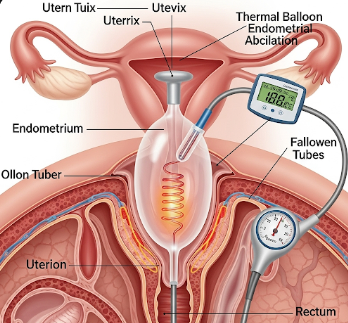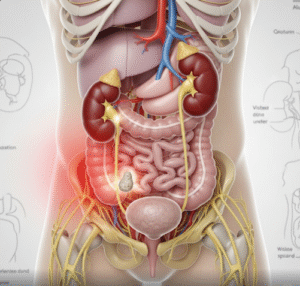Overview
Thermal balloon endometrial ablation (TBEA) is a minimally invasive gynecological procedure used to treat heavy menstrual bleeding (menorrhagia). It involves destroying the uterine lining (endometrium) using controlled heat delivered through a balloon catheter, which reduces or stops excessive bleeding.
In Korea, TBEA is performed in advanced gynecological centers with modern equipment, ensuring safety, minimal discomfort, and rapid recovery. This procedure is an alternative for women who do not respond to medications and wish to avoid hysterectomy.
What is Thermal Balloon Endometrial Ablation?
TBEA is a treatment for abnormal uterine bleeding, particularly when other therapies like hormonal medications have failed.
Key points:
- ✦ Method: A balloon catheter is inserted into the uterus and filled with heated fluid to destroy the endometrial lining.
- ➤ Effectiveness: Significantly reduces or stops menstrual bleeding in most women.
- ✦ Indications: Heavy menstrual bleeding, failed medical therapy, women who have completed childbearing.
- ➤ Alternative to hysterectomy: Less invasive, faster recovery, and preserves the uterus structurally.
What are the Benefits?
TBEA provides multiple advantages:
✅ Minimally invasive procedure with small or no incisions.
➤ Short procedure time: usually completed in 20–30 minutes.
✦ Rapid recovery: most patients return to normal activities within 1–2 days.
➤ High success rate for reducing heavy menstrual bleeding.
✅ Avoids major surgery like hysterectomy.
✦ Preserves uterine structure while alleviating symptoms.
Procedure Details
1) How should I prepare for Thermal Balloon Endometrial Ablation?
Preparation includes:
- ✦ Medical evaluation: review history of bleeding disorders, medications, and allergies.
- ➤ Imaging: ultrasound to evaluate uterine anatomy and rule out structural abnormalities.
- ✦ Laboratory tests: blood tests including hemoglobin and coagulation profile.
- ➤ Medication review: stop blood thinners or certain hormonal medications if advised.
- ✦ Consent and counseling: discuss procedure steps, risks, benefits, and alternatives.
- ➤ Pre-procedure instructions: fasting if sedation or general anesthesia is planned.
2) What happens during the procedure Thermal Balloon Endometrial Ablation?
TBEA is usually performed under local, regional, or general anesthesia:
➤ Step 1: Cervix is dilated gently to allow insertion of the balloon catheter.
✦ Step 2: The balloon is inserted into the uterine cavity and filled with heated fluid (approximately 87–90°C).
➤ Step 3: The heat is maintained for 8–12 minutes to destroy the endometrial lining.
✦ Step 4: Balloon is deflated and removed, and the uterus is rinsed if necessary.
➤ Step 5: The procedure is completed quickly, with minimal discomfort.
Korean gynecological centers ensure precise temperature control and safety monitoring during the procedure.
3) What happens after Thermal Balloon Endometrial Ablation?
Post-procedure care includes:
- ✦ Monitoring: vital signs and initial bleeding or cramping assessment.
- ➤ Pain management: mild analgesics for cramps or discomfort.
- ✦ Vaginal discharge: may experience watery or bloody discharge for several days.
- ➤ Activity guidance: avoid strenuous activity and sexual intercourse for 1–2 weeks.
- ✦ Follow-up: check-ups within 4–6 weeks to evaluate symptom improvement and healing.
- ➤ Long-term outlook: most women experience dramatic reduction in menstrual bleeding, with some achieving complete cessation.
Recovery is typically rapid, allowing patients to resume normal daily activities almost immediately.
Risks / Benefits
Potential Risks:
- ✦ Cramping, mild pelvic pain, or vaginal discharge.
- ➤ Infection (rare) requiring antibiotics.
- ✦ Uterine perforation or injury to surrounding organs (very rare).
- ➤ Incomplete ablation, potentially requiring repeat procedure.
- ✦ Rare allergic reaction to anesthesia or device materials.
Benefits:
- ✅ Minimally invasive with high effectiveness.
- ✅ Reduces or eliminates heavy menstrual bleeding.
- ✅ Short recovery period and minimal hospital stay.
- ✅ Avoids major surgery like hysterectomy.
- ✅ Preserves uterus while improving quality of life.
Recovery and Outlook
Recovery after TBEA generally includes:
- ➤ Immediate care: mild cramping and watery discharge for a few days.
- ✦ Activity: resume normal daily activities in 1–2 days; avoid heavy lifting for 1 week.
- ➤ Follow-up: evaluation for reduction in bleeding and overall satisfaction.
- ✦ Long-term outcome: most patients experience reduction in bleeding by 70–90%, with some achieving complete cessation.
- ➤ Contraception advice: TBEA is not a contraceptive; pregnancy after the procedure can be dangerous and is generally not recommended.
When To Call the Doctor
Contact your healthcare provider if you notice:
⚠ Severe or persistent pelvic pain.
⚠ Heavy bleeding or passing large clots.
⚠ Fever, chills, or foul-smelling vaginal discharge.
⚠ Signs of infection or allergic reaction.
⚠ Any unexpected complications or prolonged symptoms.
Best Korea Option / Process
Korea provides world-class TBEA with:
- ✦ Experienced gynecologists trained in minimally invasive procedures.
- ➤ Advanced thermal balloon systems with precise temperature control.
- ✦ Short procedure and recovery time for patient convenience.
- ➤ Comprehensive pre- and post-procedure care, including counseling and follow-up.
- ✦ Safe and effective treatment for both domestic and international patients.
- ➤ Minimally invasive approach preserving the uterus while resolving heavy bleeding.
Korean centers ensure patients receive safe, effective, and comfortable care for heavy menstrual bleeding with minimal risk and rapid return to daily life.
Highlights of Thermal Balloon Endometrial Ablation in Korea
- ✅ Minimally invasive treatment for heavy menstrual bleeding.
- ➤ Short procedure time (20–30 minutes).
- ✦ Rapid recovery and return to daily activities.
- ➤ High effectiveness in reducing or stopping menstrual bleeding.
- ✅ Expert pre- and post-procedure care in advanced Korean centers.













